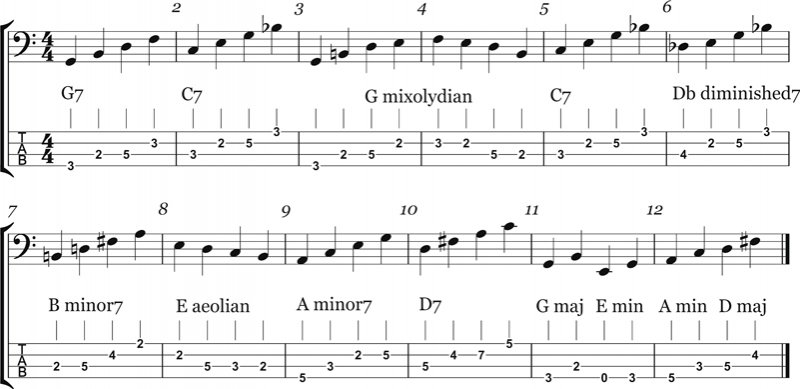Deep Thinking: Arpeggios on Bass
Deep Thinking: Arpeggios on Bass
Welcome to NZ Musician’s new bass column we’ve badged Deep Thinking! Over the next few issues, we are going to look at aspects of bass playing at various skill levels. The idea behind this column is to make you able to create bass lines in a range of styles and to increase your technical skill level.
As you will see from the notated examples, I am writing in standard notation and in bass tablature. Please use whichever method you are used to. If you are unfamiliar with bass tab, just think of your bass fingerboard as you look over it from above in the normal playing position – the bottom string (string 4, low E) is at the bottom of the tab and the highest string (string 1, G) is at the top.
The first exercise above is designed to get you used to the arpeggios – four note chord structures consisting of a root note (bottom note of the chord), third note, fifth note and seventh note – that exist in the major scale. All of these can be used as bass lines and riffs under the chords I have set out below. I have used the key of C major but the patterns or shapes themselves can be used in any key – just learn the fingerings for now.
So we see that there is a chord sequence of Major7 – Minor7 – Minor 7 – Major 7 – 7 – Minor7 – Minor7b5 (half diminished) that can be used in all keys.

Once you have worked through these patterns, we can put a few of them into action as a ‘walking’ (four quarter notes or crochets to each bar) bass line under a jazz–flavoured 12 bar chord sequence. Notice that this sequence is slightly more complex that the standard three chord 12 bar used in many blues songs. I have made it slightly harder so as to include as many of the arpeggios above as possible.
You will notice that bar 6 has a ‘diminished’ arpeggio that is not listed above and that there are a couple of ‘mode’ scales that appear in bars 3 and 4 and in bar 8. We will talk more about diminished scales and arpeggios in a later issue. Also, bars 11 and 12 contain two chords in each. In any 12 bar – blues or jazz – these bars are called ‘the turnaround’. I have only used the root note and third note of each arpeggio in these bars in order to keep four notes in each.
Dr. Rob Burns is a senior lecturer in music at the University of Otago in Dunedin. As a former professional studio bassist in the UK, he performed and recorded with David Gilmour, Pete Townsend, Jerry Donahue, Isaac Hayes, Sam and Dave, James Burton, Ian Paice and Jon Lord, Eric Burdon and members of Abba. He also played on the soundtracks of many UK television shows such as Red Dwarf, Mr. Bean, Blackadder, Not the Nine O’Clock News and Alas Smith and Jones. Rob is currently a member of Dunedin bands Subject2change and The Verlaines.)In the next issue we will look at some different scale structures (modes) that can be used to make bass lines in different styles.
